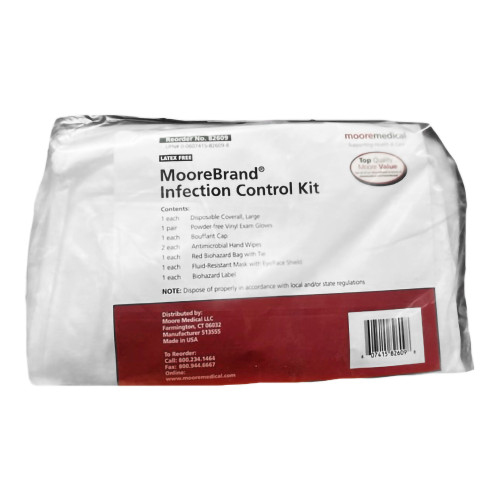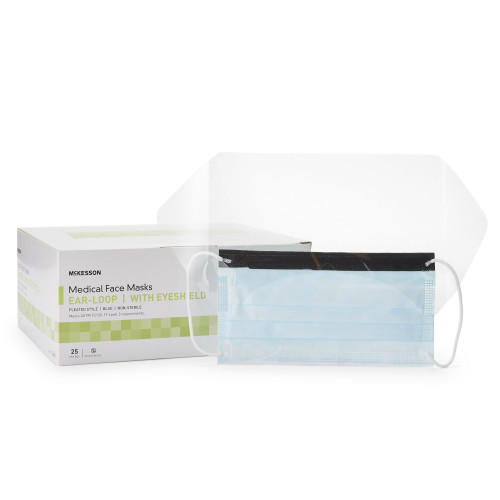-

-

ProGear
ProGear N95 Particulate Filter Respirator and Surgical Mask - ASTM Level 3
Prestige Ameritech ProGear's NIOSH and FDA approved N95 Respirator is intended to protect both patients and health care workers from the transfer of microorganisms and airborne particulate materials.Does not contain cellulose Filters out 99% of particles...
As low as $92.41 -

Honeywell
Honeywell DC365 Medical N95 Respirator Mask, Surgical Face Mask
The Honeywell DC365 Surgical N95 Respirator is an easy-to-don and doff, high fluid-resistant surgical respirator designed for clinician satisfaction across the spectrum of care. NIOSH-certified Surgical N95 (NIOSH 42CFR 84) The Honeywell DC365 Surgical...
As low as $44.08 -

McKesson
McKesson Fluid Resistant Procedure Mask with Anti-Fog Eye Shield
McKesson Procedure Masks are designed to be an economical, flat, earloop face mask with standard pleats for general patient care applications.Comfortable, cool, and breathable Blue Splash-resistant and anti-fog Single use Wrap-around visor provides...
As low as $25.80 -

McKesson
McKesson Medical Face Mask - Surgical Procedure Masks, Yellow, ASTM Level 1
McKesson medical face masks are constructed with a three-layer, nonwoven fabric featuring a spunbond polypropylene on the inner and outer layers and a meltblown polypropylene middle layer. Available in blue, yellow, and white, McKesson offers a range of...
As low as $11.45 -

McKesson
McKesson Medical Face Mask - Surgical Procedure Masks, White, ASTM Level 1
McKesson medical face masks are constructed with a three-layer, nonwoven fabric featuring a spunbond polypropylene on the inner and outer layers and a meltblown polypropylene middle layer. Available in blue, yellow, and white, McKesson offers a range of...
As low as $12.98 -

McKesson
McKesson Medical Face Mask - Surgical Procedure Masks, Blue, ASTM Level 1
McKesson medical face masks are constructed with a three-layer, nonwoven fabric featuring a spunbond polypropylene on the inner and outer layers and a meltblown polypropylene middle layer. Available in blue, yellow, and white, McKesson offers a range of...
As low as $13.99 -

McKesson
McKesson Anti-Fog Surgical Mask - Tie Closure, Pleated, Breathable - One Size
McKesson Surgical Face Masks are made from high quality materials to allow for a high level of breathability. All face masks are single-use and available in a variety of styles suitable for a variety of applications.Special construction to reduce fogging...
As low as $17.79 -

Touch of Life
Touch of Life Nitrile Examination Gloves, Disposable, Powder-Free
Powder-free exam gloves are packed with a larger quantity per box (250 per box) to help save time and reduce waste.Chemotherapy drugs tested: 5-Fluorouracil, Carmustine (BCNU), Cisplatinum, Cyclophosphamide (Cytoxan), Dacarbazine (DTIC), Doxorubicin...
As low as $32.54 -

McKesson
McKesson Surgical Masks for Kids - Disposable, Medical Face Mask
Soft, lightweight material for cool comfort; comfortable knitted earloops for a custom fit on small faces Formable nose wire forms a snug seal for increased protection; spunbond outerlayer material helps provide protection against fluids Bacterial...
As low as $16.14 -

McKesson
McKesson Oral Thermometer Probe Cover, 50 per Box
Oral Thermometer Probe Covers, manufactured by Mckesson, are disposable probe covers designed to create a safe environment for taking temperatures, reducing the risk of contamination by sharing a single thermometer. These Thermometer Probe Covers are...
As low as $10.67 -

Touch of Life
Touch of Life Black Nitrile Exam Gloves, Disposable, Powder-Free
Powder-free exam gloves are packed with a larger quantity per box (250 per box) to help save time and reduce waste.Chemotherapy drugs tested: 5-Fluorouracil, Carmustine (BCNU), Cisplatinum, Cyclophosphamide (Cytoxan), Dacarbazine (DTIC), Doxorubicin...
As low as $24.72
Personal Protective Equipment

Personal Protective Equipment (PPE)
The COVID-19 pandemic may have brought the phrase “personal protective equipment (PPE)” into widespread use. Whether you’re trying to protect yourself or someone else, understanding the different types of PPE is essential.
Face Masks
There are two distinct types of masks, and which one is most appropriate for you depends on your purpose for wearing it. Medical masks, or surgical masks (the type of disposable mask most people are now familiar with), primarily protect you from droplets or splashes of liquid and filter out large particles. However, they do not fit tightly or form a seal and offer little to no protection against airborne pathogens.
Respirator masks (such as the “N95” masks discussed so often) are more effective overall; they fit the contours of the wearer’s face and filter out both large and small particles while also protecting them from droplets. In addition, respirator masks filter out at least 95% of airborne pathogens. Respirator masks include the N95, KN95, and FFP2.
Face Shields
Some infections spread through contact with the mucous membranes in the eyes. Disposable face shields, consisting of a clear plastic full-face visor attached to a headband, protect your eyes from droplets and splashes that contaminate them with infectious microorganisms. Some types of face masks may also have a built-in clear plastic face shield that extends upward from the top of the mask and protects the eyes.
Gloves
Disposable gloves protect both the wearer and anyone they may touch. They protect the person wearing them from any microorganisms their hands may come in contact with and others from any pathogens that may be present on the wearer’s hands. Gloves come in various sizes, and it’s important to choose gloves that fit snugly but not tightly.
Gloves are often made of latex, though nitrile is also common. If you have a latex allergy, ensure that the gloves you choose are nitrile or clearly state that they are latex-free. Powder dusting the inside of the gloves makes them easier to put on and take off, and keeps hands dry, which may be helpful if you will be wearing gloves for long periods or in hot conditions. If you want to avoid powder, look for a brand labeled powder-free.
Gowns
Like gloves, gowns can protect both the wearer and those around them. Gowns offer four different levels of protection, suitable for different situations.
The COVID-19 pandemic may have brought the phrase “personal protective equipment (PPE)” into widespread use. Whether you’re trying to protect yourself or someone else, understanding the different types of PPE is essential.
Face Masks
There are two distinct types of masks, and which one is most appropriate for you depends on your purpose for wearing it. Medical masks, or surgical masks (the type of disposable mask most people are now familiar with), primarily protect you from droplets or splashes of liquid and filter out large particles. However, they do not fit tightly or form a seal and offer little to no protection against airborne pathogens.
Respirator masks (such as the “N95” masks discussed so often) are more effective overall; they fit the contours of the wearer’s face and filter out both large and small particles while also protecting them from droplets. In addition, respirator masks filter out at least 95% of airborne pathogens. Respirator masks include the N95, KN95, and FFP2.
Face Shields
Some infections spread through contact with the mucous membranes in the eyes. Disposable face shields, consisting of a clear plastic full-face visor attached to a headband, protect your eyes from droplets and splashes that contaminate them with infectious microorganisms. Some types of face masks may also have a built-in clear plastic face shield that extends upward from the top of the mask and protects the eyes.
Gloves
Disposable gloves protect both the wearer and anyone they may touch. They protect the person wearing them from any microorganisms their hands may come in contact with and others from any pathogens that may be present on the wearer’s hands. Gloves come in various sizes, and it’s important to choose gloves that fit snugly but not tightly.
Gloves are often made of latex, though nitrile is also common. If you have a latex allergy, ensure that the gloves you choose are nitrile or clearly state that they are latex-free. Powder dusting the inside of the gloves makes them easier to put on and take off, and keeps hands dry, which may be helpful if you will be wearing gloves for long periods or in hot conditions. If you want to avoid powder, look for a brand labeled powder-free.
Gowns
Like gloves, gowns can protect both the wearer and those around them. Gowns offer four different levels of protection, suitable for different situations.
- Level 1 is for basic care, isolation, or as cover for visitors to the particularly vulnerable.
- Level 2 is appropriate for low-risk situations, such as when drawing blood.
- Level 3 is for moderate-risk scenarios such as inserting IVs or arterial blood draws.
- Level 4 is the highest level of protection, appropriate in cases of the infectious but non-airborne disease.
